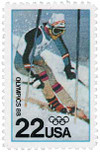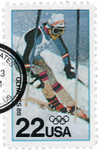
# 2369 - 1988 22c Winter Olympics
U.S. #2369
1988 22¢ Winter Olympics
- Issued to promote the 1988 Winter Olympic Games in Calgary, Canada.
- 8th Winter Olympics stamp to picture a skier
Stamp Category: Commemorative
Value: 22¢, first-class rate
First Day of Issue: January 10, 1988
First Day City: Anchorage, Alaska
Quantity Issued: 158,870,000
Printed by: American Bank Note Company
Printing Method: Photogravure
Format: Panes of 50 in sheets of 200
Perforations: 11
Why the stamp was issued: To promote the 1988 Winter Olympic Games in Calgary, Canada.
About the stamp design: Bart Forbes provided the artwork for this stamp. Initially, the USPS requested that he create a design inspired by travel posters, to create something different from previous Olympic stamps that pictured athletes. Some of his designs included the Calgary skyline, a grain elevator, mountains, and Canada geese. However, the Citizens’ Stamp Advisory Committee realized that these images didn’t properly symbolize the Olympics, and asked Forbes to illustrate an athlete. Some of his early designs included a ski jumper and a luge racer. His final design shows an Alpine skier moving down a mountain, past a slalom gate.
First Day City: The First Day ceremony for this stamp was held in Anchorage, Alaska, to help that city promote its bid to host the 1994 Winter Olympic Games.
About Olympics Stamps: In 1932, the US Post Office Department issued its first stamp honoring the Olympics Games. 1932 marked the third time the Winter Olympic Games were held, and the first time the event was held in the US. The games were held in Lake Placid, a small town in upstate New York that was home to less than 3,000 year-round residents.
Less than five months later, the Post Office issued its second and third Olympics stamps, honoring the summer games. Both stamps were issued on June 15, 1932, in Los Angeles, California, the site of the games.
It would be nearly 30 years before the US issued another stamp honoring the Olympics. That issue commemorated the 1960 Winter Olympics held in Squaw Valley, California. Since 1972, the USPS has issued stamps for most Summer and Winter Olympic Games.
History the stamp represents: On February 13, 1988, the Winter Olympics opened in Calgary, Alberta, Canada. They were the first Winter Olympics held in Canada and a record number of nations participated for the time.
Calgary was selected as the host city in 1981. The city built five brand-new venues for the games and they were the most expensive Olympics held up to that time. The role of television in these games was significant. Popular events such as ice hockey and figure skating were scheduled for prime time. The games were extended from 12 days to 16 so that they could air on three weekends.
The Games opened on February 13, 1988. The $10 million opening ceremony included 5,500 performers, a flyover by the Canadian Air Force, and the release of 1,000 homing pigeons. Throughout the games, weather was a constant concern. There were high winds and temperatures rose to 63 °F. Because of the high temperatures, they had to use artificial snow for some events, an Olympic first.
In men’s figure skating, viewers were treated to the “Battle of the Brians,” with Brian Boitano of the US competing against Canada’s Brian Orser. The two Brians first competed in 1987 at the World Junior Figure Skating Championships. In both contests, Brian Boitano bested his rival.
Some athletes made news for their diligence and not their skill. Eddie “The Eagle” Edwards was a ski jumper from Great Britain. Since England doesn’t have mountains to ski on, he came to America to train. Being the only British ski jumper, he qualified for the Olympics. He came in last in both events but people around the world cheered for him. At the closing ceremonies, the president of the Olympic Organizing Committee was congratulating the athletes on their success and said, “Some of you have even soared like an eagle.” The crowd erupted with cheers of “Eddie! Eddie!” He became the first athlete to ever be mentioned in a closing ceremony speech. Edwards received more publicity than the gold medal winner, Matti Nykanen of Finland. In 2016, Eddie’s story was retold in the film, Eddie the Eagle.
The Jamaican national bobsled team also received more than its share of media attention. Being from a tropical country, the four-man team had very little chance to practice. Because of a lack of money, they borrowed sleds from other teams to compete. The team was the idea of two American businessmen who had spent time in Jamaica. Since bobsled racing requires a quick start, they decided to train sprinters. Though they didn’t finish their race after a crash, they improved throughout the competition. The 1993 Disney film Cool Runnings was based on the experience of the team. In the 1994 Winter Olympics, the Jamaican team surprised many critics with their 14th place finish, which was better than teams from the US, Russia, and France.
The Calgary Games closed on February 28, 1988. In all, more than 1,400 athletes from 57 nations participated in the games. The Soviet Union and East Germany took the most medals overall, while Canada failed to win any gold medals. The Calgary Olympics cost about $829 million. However, because the organizing committee worked out lucrative television and sponsorship deals, they actually made a surplus. They reported $1.4 billion in benefits throughout Canada as a result of the games. Additionally, the venues they built for the games remained in use and helped establish the area as the center of Canada’s winter sports industry.
U.S. #2369
1988 22¢ Winter Olympics
- Issued to promote the 1988 Winter Olympic Games in Calgary, Canada.
- 8th Winter Olympics stamp to picture a skier
Stamp Category: Commemorative
Value: 22¢, first-class rate
First Day of Issue: January 10, 1988
First Day City: Anchorage, Alaska
Quantity Issued: 158,870,000
Printed by: American Bank Note Company
Printing Method: Photogravure
Format: Panes of 50 in sheets of 200
Perforations: 11
Why the stamp was issued: To promote the 1988 Winter Olympic Games in Calgary, Canada.
About the stamp design: Bart Forbes provided the artwork for this stamp. Initially, the USPS requested that he create a design inspired by travel posters, to create something different from previous Olympic stamps that pictured athletes. Some of his designs included the Calgary skyline, a grain elevator, mountains, and Canada geese. However, the Citizens’ Stamp Advisory Committee realized that these images didn’t properly symbolize the Olympics, and asked Forbes to illustrate an athlete. Some of his early designs included a ski jumper and a luge racer. His final design shows an Alpine skier moving down a mountain, past a slalom gate.
First Day City: The First Day ceremony for this stamp was held in Anchorage, Alaska, to help that city promote its bid to host the 1994 Winter Olympic Games.
About Olympics Stamps: In 1932, the US Post Office Department issued its first stamp honoring the Olympics Games. 1932 marked the third time the Winter Olympic Games were held, and the first time the event was held in the US. The games were held in Lake Placid, a small town in upstate New York that was home to less than 3,000 year-round residents.
Less than five months later, the Post Office issued its second and third Olympics stamps, honoring the summer games. Both stamps were issued on June 15, 1932, in Los Angeles, California, the site of the games.
It would be nearly 30 years before the US issued another stamp honoring the Olympics. That issue commemorated the 1960 Winter Olympics held in Squaw Valley, California. Since 1972, the USPS has issued stamps for most Summer and Winter Olympic Games.
History the stamp represents: On February 13, 1988, the Winter Olympics opened in Calgary, Alberta, Canada. They were the first Winter Olympics held in Canada and a record number of nations participated for the time.
Calgary was selected as the host city in 1981. The city built five brand-new venues for the games and they were the most expensive Olympics held up to that time. The role of television in these games was significant. Popular events such as ice hockey and figure skating were scheduled for prime time. The games were extended from 12 days to 16 so that they could air on three weekends.
The Games opened on February 13, 1988. The $10 million opening ceremony included 5,500 performers, a flyover by the Canadian Air Force, and the release of 1,000 homing pigeons. Throughout the games, weather was a constant concern. There were high winds and temperatures rose to 63 °F. Because of the high temperatures, they had to use artificial snow for some events, an Olympic first.
In men’s figure skating, viewers were treated to the “Battle of the Brians,” with Brian Boitano of the US competing against Canada’s Brian Orser. The two Brians first competed in 1987 at the World Junior Figure Skating Championships. In both contests, Brian Boitano bested his rival.
Some athletes made news for their diligence and not their skill. Eddie “The Eagle” Edwards was a ski jumper from Great Britain. Since England doesn’t have mountains to ski on, he came to America to train. Being the only British ski jumper, he qualified for the Olympics. He came in last in both events but people around the world cheered for him. At the closing ceremonies, the president of the Olympic Organizing Committee was congratulating the athletes on their success and said, “Some of you have even soared like an eagle.” The crowd erupted with cheers of “Eddie! Eddie!” He became the first athlete to ever be mentioned in a closing ceremony speech. Edwards received more publicity than the gold medal winner, Matti Nykanen of Finland. In 2016, Eddie’s story was retold in the film, Eddie the Eagle.
The Jamaican national bobsled team also received more than its share of media attention. Being from a tropical country, the four-man team had very little chance to practice. Because of a lack of money, they borrowed sleds from other teams to compete. The team was the idea of two American businessmen who had spent time in Jamaica. Since bobsled racing requires a quick start, they decided to train sprinters. Though they didn’t finish their race after a crash, they improved throughout the competition. The 1993 Disney film Cool Runnings was based on the experience of the team. In the 1994 Winter Olympics, the Jamaican team surprised many critics with their 14th place finish, which was better than teams from the US, Russia, and France.
The Calgary Games closed on February 28, 1988. In all, more than 1,400 athletes from 57 nations participated in the games. The Soviet Union and East Germany took the most medals overall, while Canada failed to win any gold medals. The Calgary Olympics cost about $829 million. However, because the organizing committee worked out lucrative television and sponsorship deals, they actually made a surplus. They reported $1.4 billion in benefits throughout Canada as a result of the games. Additionally, the venues they built for the games remained in use and helped establish the area as the center of Canada’s winter sports industry.









